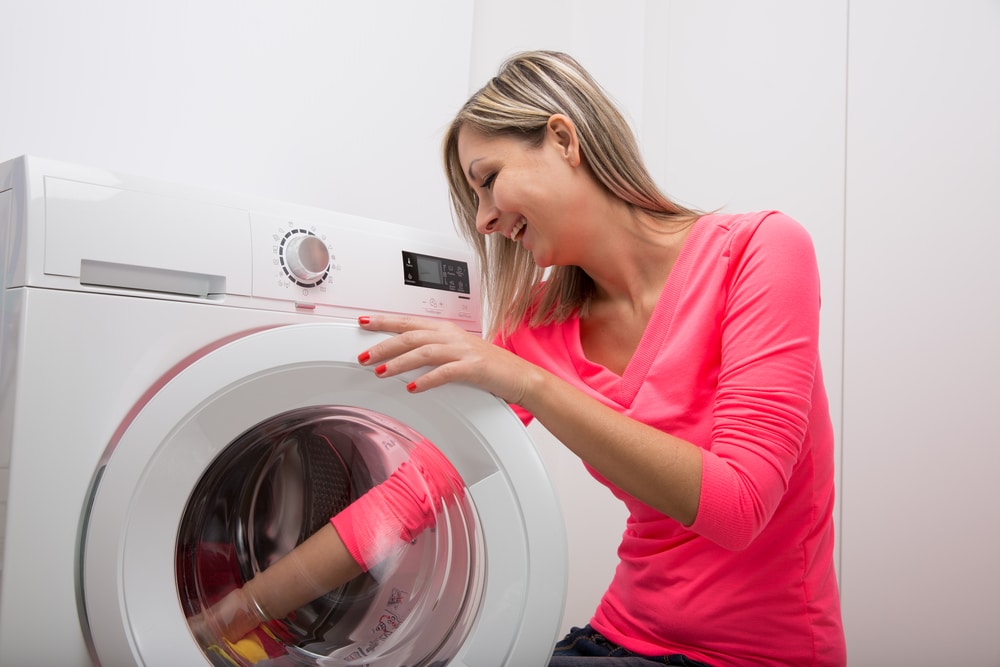Last Updated on
It’s common for limescale to build up on steam generator irons, leading to rust, poor performance, and even breakage. Limescale can also hinder water flow within the iron, leading to brown water marks on your clothes.
Thankfully, there are a few methods to stop limescale from forming in the first place. Regular descaling will prevent buildup and will help keep your steam generator iron last long. We recommend cleaning an iron around every three months.
You also need to remove any remaining water from the water tank after use and, if possible, use filtered water. The more mineral deposits in the water, the higher the chances of encountering limescale buildup.
How to Clean a Steam Generator Iron: 3 Steps
Here is our step-by-step guide for keeping steam generator irons in excellent condition.
Step 1: Descaling the Iron
If your steam generator iron has an anti-calc function, do the following:
- Set the iron’s steam output to ‘none’ and turn the temperature dial to maximum.
- Switch on the iron and allow it to reach its maximum temperature.
- At this point, unplug the appliance from the wall socket.
- Set the steam output to maximum.
- Place the iron over a sink and press the calc-clean button as you gently shake the iron to remove any leftover water from the water reservoir.
- Add fresh, clean water to the reservoir.
- Plug the iron into an electrical output and heat it to the maximum temperature again until all tap water has evaporated.
- Press the ‘clean’ function. Unplug the iron and allow it to cool.
Step 2: Cleaning the Soleplate
To keep steam irons in the best condition possible, you’ll need to thoroughly and frequently clean the soleplate. Take precautions never to use an abrasive cloth on this area as it can scratch the surface, resulting in an increased chance of burning your garments when ironing. You should also remove the iron from the wall socket and allow it to cool before attempting the cleaning process.
Dealing With Stains
For stubborn stains on the soleplate, soak a linen cloth in white vinegar. Add some tap water to the cloth and wipe the soleplate surface. Alternatively, if the soleplate isn’t in that bad of a condition, add some baking soda with vinegar to a soft cloth and smooth over the surface.
Declogging Vent Holes
It’s common for an iron’s vent holes to become clogged, and you can use cotton swabs dipped in white vinegar to remove any blockages.
Scraping Melted Plastic
It’s not all that common for plastic to melt onto your iron’s soleplate. For occasions like this, place some aluminium foil on top of your ironing board and sprinkle some salt on top. Then, iron over this salt and the foil. This action will help to loosen the melted plastic on your iron.
If you discover that there’s still some plastic remaining on your soleplate, you can scrape this off using a metallic tool. Otherwise, this plastic could become to scrape and damage your steam generator iron.
Step 3: Cleaning the Reservoir
The reservoir is a common part of steam irons that needs a regular and thorough cleaning. To keep this section of your steam generator iron clean and in optimal condition, you can mix one tablespoon of organic vinegar with two tablespoons of distilled water.
Then, fill the reservoir with this cleaning agent and set your iron to its highest temperature. Allow the iron to produce steam from the steam vents for around five minutes to allow this solution to get to work on the inner components.
Manually Descaling Steam Generator Irons
You must regularly descale your steam generator iron, as we just explained, to maintain it operating properly. Fortunately, devices like the Philips steam generator iron come with a built-in anti-calc system that means the steam iron practically descales itself at the press of a button. Refer to the user manual on how to use this feature.
However, if your appliance doesn’t have this function, here are steps on how to descale an iron.
Step 1: Vinegar and Water
To get rid of mineral deposits, mix equal parts of white vinegar with water. Then, wipe the soleplates with a clean, soft cloth, and cover this cloth with the mixture. Fill up the water tank to around halfway. Switch on the steam generator iron and press the steam trigger to generate high heat. This action enables the vinegar solution to move through the soleplates and provide a thorough clean.
Step 2: Refill With Fresh Water
Once the water runs low or empties, fill the water reservoir up to the halfway point again, keeping the steam function on, and allow time for the steam to manoeuvre through the iron until the tank is rid of water.
Step 3: Let Cool and Check For Further Cleaning
Leave the iron to cool. Only at this point should you examine the soleplates for further cleaning. If you notice a buildup of debris and marks, use a cotton bud and dip this into any remaining vinegar solution and apply the cotton bud to these areas.
FAQs about Steam Generators
Can you use a cleaning product for descaling?
The cleaning market is beaming with various products promising to provide a deep clean for steam generators and other types of irons. Still, many abrasive cleaners can be harsh to your iron, making it more susceptible to damage.
Therefore, we recommend avoiding pre-bought cleaning products and sticking to all the vinegar solutions you can to prevent any malfunctions. This also means that you’re only using natural products and, thus, not putting any chemicals onto the iron that could then rub off your clothing, causing damage or fading.
Do you need to clean your steam generator iron after every use?
Fortunately, the answer to this is no. In particular, if you use demineralising water, you won’t need to perform thorough maintenance of your steam iron compared to someone who just uses unfiltered tap water. This is because demineralising water doesn’t contain any minerals, resulting in no buildup internally.
But simply using this type of water won’t completely escape you from cleaning altogether. Instead, you’ll need to keep your steam generator iron clean by regularly wiping down the soleplate and external components to keep it clean.
How often should you clean your steam generator iron?

There’s no one set answer for everyone, and you should certainly consider how often you use your steam generator iron along with its durability and condition. However, if you’re using hard water in the tank, we recommend a weekly cleaning session to ensure its performance is at its best.
Furthermore, we suggest performing a physical inspection to ensure that your steam generator iron is up to scratch, such as checking for any white scale substance leaving the iron once you use it. You may also notice that the steam power has decreased recently, implying that the steam generator needs a thorough internal cleaning. Another common sign you need to clean your steam generator iron is if it leaves dark stains and marks on your clothes after ironing.
Clean Your Steam Generator Iron Today
Now that you know how to clean a steam generator iron keeping your appliance in tip-top shape has never been easier. Just follow our guide to remove brown stains, melted plastic and more from your iron. Remember that vinegar is a great option when descaling light deposits on your iron.
If you own a steam generator iron, how often do you descale it? What cleaning agents do you use? Let us know your feedback in the comments.
Amy is a U.K.-based writer and editor with a penchant for helping consumers find the best home products for their needs, as well as providing easily digestible guides for living better at home. Her dedication to her work means she can usually be found elbow-deep in research or hunting down samples of the latest and greatest on behalf of her readers.
An avid DIYer herself, Amy’s passion lies in teaching others how they too can achieve their dream homes by tackling some of those pesky projects themselves! Whether it’s building furniture from scratch or turning an old dresser into a coffee table, Amy is always happy to share what she knows about making your house feel like home without spending a fortune.



